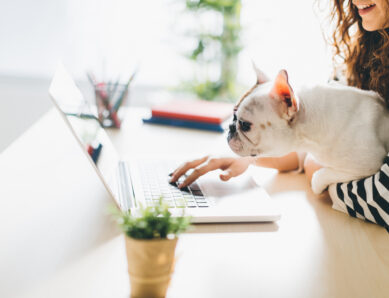It’s 8 a.m. You’re about to leave home, travel mug of coffee in one hand, phone in the other. You’re looking for your keys when you glance down and see a pair of large, brown eyes staring back at you.
“I’m sorry, Rover. You’ll have to stay here. Come on, don’t look at me like that. I’m sorry, I can’t take you to work. Don’t worry, the dog walker will be here soon. Give me a break! Stop staring at me!“
For the rest of the day you’re riddled with guilt about leaving your dog alone, and nervous about the state your home will be in when you get back. But what if this didn’t have to be the case?
A rising number of companies are introducing pet-friendly workplaces. Not only have studies heralded the impact dogs can have on workplace stress, but many reports also highlight improved morale and work-life balance in the workforce. But bringing little Rover into the office can bring its own stresses.
See our pointers below on the potential highs and lows of working around office dogs.
Does Having an Office Dog Help Creativity?
So, your office has agreed to a trial run of dogs at work? Excellent! No more puppy eyes through the letterbox: Rover can come to the office with you!
And, as soon as you get to work, you’re bombarded by colleagues itching to get some face time with your fluffy companion. With Rover by your side, you’ve had engaging conversations with coworkers you’d barely managed to say “hi” to in the past.
This continues throughout the day. Normally people would just email you if they had a question. Now, they’re walking over to your desk to have a chat, and give your dog a belly rub. Small talk soon turns into intelligent conversation, and before you know it you’re being included in new creative projects, all because you finally spoke to your colleagues face to face.
But there are downsides too. You work in an open-plan office, and Rover has free rein. You may no longer be worrying about what your dog’s doing at home, but now you’re constantly scanning the room to check he’s not misbehaving.
“Where is he? Is he bothering Neil? Rover, get back here! Sorry Neil!“
Why Dogs at Work Can Make or Break Relationships
While many people would likely jump at the chance to work somewhere with dogs, this isn’t the case for everyone. Feelings can range from indifference to a genuine phobia of dogs. Not to mention the reaction of colleagues who suffer from allergies. You may love bringing your dog to work, but this shouldn’t come at the cost of other people’s discomfort.
If you’re involved in the recruitment of new staff, be sure to advertise the nature of your office culture clearly to prospective candidates. You could save yourself a hairy situation further down the line.
It’s important to maintain an open dialogue with your co-workers. And keep in mind that bringing your dog to work is a perk, not a right. If someone is uncomfortable around your dog, it is your responsibility to accommodate their concerns. Whether that means keeping your dog on a lead, or if needs be, leaving it at home.
Embarrassing Office Dog Moments
Let’s spare a thought for your company’s HR team. Keeping things civil in an office full of humans can be difficult enough. But now add a bunch of excitable balls of fluff to the mix. It’s not like anyone can give Lucky the beagle a disciplinary for stealing someone’s sandwich!
Each person’s dog is his or her own responsibility. Just because you’re a busy manager, doesn’t mean that you can expect your PA to clean up your dog’s messes. If you want to take advantage of your organization’s pro-dog policy, be prepared to deal with your dog’s “faux pas” in a professional manner.
How to Manage Your Dog at Work
If you’re thinking of taking your dog to work, the most important thing to consider is its well-being. Will your dog feel relaxed, or could a busy office environment cause it undue stress?
Pro-canine organizations such as Nestlé use specialists to assess the suitability of each dog to an office environment. Your organization might not implement such thorough vetting of your four-legged friends, but there are simple steps you can take to make sure your dog is happy and well-behaved at work.
Make sure your dog has a recognizable safe place, for example, a bed under, or next to, your desk. Don’t let it find its own space, otherwise it could become territorial. Your colleagues won’t take kindly to avoiding the photocopier because Rover has decided it’s his “spot.”
Try to avoid offering treats to your dog if there are other dogs around. Dogs can easily become excitable around food, and may even become aggressive if they sense competition. In fact, try to avoid giving your dog any food at all while you’re at work.
Dogs in the office can be a great perk. But for all the positives, it’s important to remain professional. You know your dog better than anyone, so you’re likely the best placed to assess their suitability to an office environment. If you’re in any doubt, then maybe it’s best to leave Rover at home. Besides, he’ll still be there when you get home, even if your house is a little the worse for wear.
Does your company allow dogs at work? How do you feel about working with animals in the office? Share your thought in the Comments section, below.



